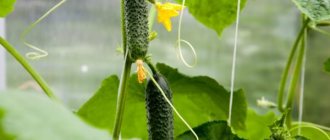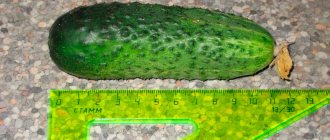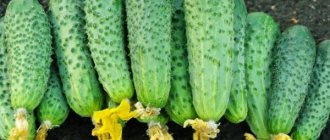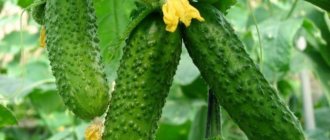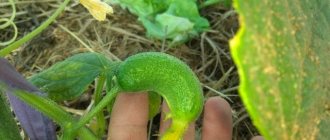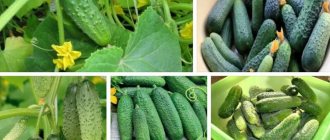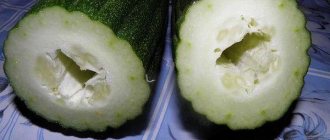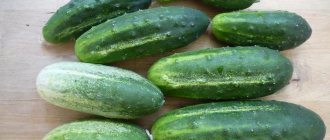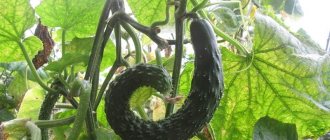Characteristics and description of cucumbers Lukhovitsky F1
Cucumber Lukhovitsky F1 is a hybrid that is suitable for growing in open ground under film covers and in greenhouses.
The designation “F1” in the name indicates that the hybrid was bred by crossing two cucumber varieties. The resulting variety combines the best parental qualities. Therefore, Lukhovitsky F1 cucumbers are distinguished by rapid ripening, disease resistance and excellent fruit quality. The peculiarity of the hybrid is also that it does not propagate by its own seeds. Therefore, new seed must be purchased every year.
The ripening period of Lukhovitsky F1 cucumbers is early - 45-50 days from emergence to the beginning of fruiting. The hybrid is parthenocarpic, which means it can set fruit in the absence of pollinating insects. This is especially suitable for growing in greenhouses or in bad weather when bee flights are limited. Cucumber Lukhovitsky F1 blooms mainly with female flowers, 1-3 pcs. in one node.
Important! Lukhovitsky F1 cucumbers have excellent commercial quality, good shelf life and transportability.
The plant is indeterminate - the growth of the stem is unlimited. The climbing ability of the Lukhovitsky F1 hybrid is average, the leaves are of medium size and green in color. Zelentsy grow 10-13 cm long, cylindrical in shape with a finely tuberous surface. The color of the fruit is dark green with light, blurred stripes of medium length. The pubescence is brown and dense. Fruit weight – 100-120 g. Greens are leveled, do not overgrow, do not turn yellow. The harvest yield is friendly and long-lasting.
Harvesting and application
Picking cucumbers daily increases fruiting. Vegetables do not turn yellow or overripe, but it is better to remove them at least every other day.
Thanks to their thin skin, cucumbers are suitable for salads, canning and pickling. Snacks made from slightly undergrown fruits are especially tasty. To do this, they are collected daily.
To keep the harvest longer, cucumbers are cut, leaving a little of the stem. At home, store in the refrigerator in plastic bags. This way they remain fresh for up to a week without losing their presentation.
Pros and cons of the cucumber variety Lukhovitsky F1
Hybrid Lukhovitsky F1 is early ripening and can be grown in areas with different climates. The formation of bunched ovaries allows you to obtain a high yield of cucumbers of the same size, which do not overgrow and ripen evenly. The fruits are suitable for transportation and storage. The hybrid can be grown through seedlings, as well as by direct sowing in the ground.
No disadvantages were found in Lukhovitsky F1 cucumbers. It is only important to take into account that the seeds of the first generation hybrid produce products of the declared quality only in the first year of cultivation.
Reviews
Maria, 42 years old, Stavropol
I always try to pickle and pickle as many cucumbers as possible during the summer season. As soon as my beloved Lukhovitskie gherkins are ready at the dacha, followed by Zyatek and Mother-in-law, I begin to actively prepare them. No matter how much you close it, everything sells out with a bang over the winter! The cucumbers are vigorous, strong and crispy, and are excellent for salting and pickling.
We buy seeds from agro in a specialized store. So far we haven't let you down even once. The germination rate is high and they grow well, they practically do not get sick.
Andrey, 36 years old, Sibay
I always wanted to get my harvest of real Lukhovitsky cucumbers. I recently saw seeds of a hybrid with that name on sale and immediately got excited. In mid-April, I started preparing the seedlings, then planted them in a greenhouse, formed the bushes into one stem, and fertilized them. The harvest was good, but the taste was still not what I expected.
Irina, 65 years old, Kaluga
I would like to recommend to everyone the hybrid cucumbers Lukhovitsky f1. I really liked it. Tasty and aromatic, crispy, the seeds are small, sweet, there is no bitterness at all. I planted ten bushes to test and from each I managed to collect 5-6 kilograms of gherkins. There are no barren flowers; there are several ovaries at each node. The harvest began to pour in very quickly and amicably. We ate a lot of cucumbers fresh and lightly salted, but most of them were covered - pickled and pickled. For preservation, I selected greens that were 8-9 cm in size so that they would fit more tightly into jars and look beautiful.
Alexandra, 40 years old, Moscow
I often buy cucumbers at the market and during the season I see Lukhovitsky on almost every counter. But in their appearance: size, shape, color, pimples, they are completely different. Are they lying? It turns out that now you can definitely buy Lukhovitsy only in Lukhovitsy. Well, or raise them yourself.
Konstantin, 65 years old, Shatura
In our greenhouse, the cucumber variety Lukhovitsky F1 is the first to ripen. We have been planting them for four years now and are very pleased. We are reaping good harvests. The resulting greens are almost all marketable: smooth and beautiful, though spiky and prickly, but most suitable for home pickles. We sell some of it, but close a lot ourselves and then eat it all winter.
Optimal growing conditions
Cucumbers are grown in sunny places. The culture needs lighting for 12-14 hours a day. Cucumber Lukhovitsky F1 with a female type of flowering sheds flowers when there is a lack of light. Also, the number of ovaries decreases when grown in overheated air and dry soil. In conditions of high temperatures, the cucumber crop is artificially increased in humidity, for example, using fogging units.
Advice! Cucumbers require feeding throughout the growing season. But they need to be applied evenly and in small quantities.
Cucumbers are a heat-loving crop that develops only at temperatures above +15°C. Does not tolerate drafts and sudden temperature changes. Optimal daytime temperatures for growing Lukhovitsky F1 cucumber are +20… +28°С, at night – + 15… +18°С.
The soil for growing must be fertile, well-drained and breathable. Stagnation of water at the roots is dangerous for the crop. Sandy loam soils with neutral acidity are most suitable.
Cucumbers need to be planted every year in a new place and the crop must be returned to its original soil only after 4 years. The best predecessors are: nightshades, cabbage and onions. Cucumbers are not planted after potatoes, pumpkins and zucchini.
Diseases and parasites
Lukhovitsky f1 is a cucumber variety that is resistant to most crop diseases: mosaic, olive spot, powdery mildew and bacteriosis. However, failure to comply with agrotechnical procedures leads to the invasion of pests such as aphids or spider mites, and Lukhovitsky bushes are also susceptible to fusarium. We invite you to familiarize yourself with the description of diseases and methods of combating them.
Aphid
Aphids are small pests that are located on the lower plate of leaves. When an aphid invades, sticky droplets form on the cucumber foliage, the leaves change shape, begin to curl and wither. In addition, withering and death of the inflorescences and ovaries of the plant are observed. To combat the pest, vegetable growers suggest using the substances “Aktara”, “Karbofos”, “Iskra-Bio” and “Tanrek”.
Spider mite
Spider mites are a dangerous pest located on the foliage of a plant. As the insect feeds on the sap of cucumber bushes, their growth slows down, small white dots form on the bottom of the leaves, and a white web forms on the stem and leaves. To get rid of spider mites, experts recommend treating the plant with the chemicals Actellik, Apollo, Neoron, Karbofos, Fitoverm, or Anti-mite.
Fusarium
Fusarium wilt is a disease of cucumbers resulting from increased soil acidity, contamination of soil or seeds, sudden changes in air temperature, pest invasion and insufficient amounts of mineral components in the soil.
The main symptoms of fusarium are the gradual withering of cucumber leaves, the formation of a pink coating on the stems, darkening and cracking of the stem, yellowing and death of the plant ovaries. It is recommended to treat bushes for fusarium with the drugs “Fundazol”, “Gymnast”, “Previkur Energy”, or “Quadris”.
Cucumber agricultural technology Lukhovitsky F1
It is most favorable to grow Lukhovitsky F1 cucumbers on high, warm ridges. Organic beds are made from layers of compost and soil mixed with manure. Such a bed gives off a lot of nitrogen, which is especially important for growing crops. A warm, fertilized bed must be prepared from the previous season.
Planting seedlings
Growing the Lukhovitsky F1 cucumber through seedlings allows you to get an earlier harvest, and in the Northern regions it is the only possible method of cultivation.
The time for planting seedlings depends on the climate and the place where the crop will be grown. The Lukhovitsky F1 cucumber should be in the seedling stage for no more than a month. This time is counted in reverse order from the date of planting in the ground, when the constant temperature at the growing site begins to exceed +15°C.
Important! Lukhovitsky F1 cucumber seeds are processed and do not require pre-sowing preparation. Seeds are sown dry in the ground.
Young cucumber seedlings do not tolerate picking well. Therefore, it is not recommended to plant seeds in a common container, where the roots of the plants can get mixed up with each other and be damaged during transplantation.
Seeds are first grown in separate cassettes. And when the leaves begin to close together, the seedlings are transplanted into containers twisted from a bag. So, it will be convenient to plant them in the ground by unrolling the package.
The soil for seedlings is prepared from garden soil with the addition of humus and baking powder in the form of old sawdust or coconut substrate.
The seeds are laid out on the soil, buried 1 cm and covered. The crops are covered and left in a dark, warm place at a temperature of +22... +25°C. Germination time is 4-7 days. Crops are checked every day, ventilated and watered if necessary. When seedlings appear, the cover is removed and placed in a sunny place. The temperature is reduced for a week to +18°C.
On cloudy days, plants must be illuminated with phytolamps so that the amount of light is 10-12 hours per day. At night the lamps are turned off.
Cucumber seedlings are fed twice:
- The first time after the appearance of one true leaf. Add an infusion of bird droppings in a ratio of 1:20 or ammonium nitrate in a ratio of 1 tsp. on a bucket of water. If the soil was highly nutritious when planting and the plants look healthy, you can skip the first fertilizing.
- The second feeding is carried out 3-4 days before planting the seedlings in the ground. At this time, complex mineral fertilizers are used.
Cucumbers are watered more often than other seedling crops. In one watering, the earthen ball is completely moistened. The next watering is carried out after the surface of the soil begins to dry out, but remains slightly moist. Water temperature for irrigation – +25°С.
The seedlings are transplanted when 5-6 true leaves appear. The height of seedlings ready for transplanting reaches 20-25 cm. The stem should be in a vertical position. A week before transplanting, the plants are hardened off, gradually increasing the time spent in conditions of more air and light.
Landing in the ground
Lukhovitsky F1 cucumbers are suitable for growing by direct sowing in open ground or a greenhouse. To do this, several seeds are sown in one hole, and after germination, one of the strongest plants is left. The remaining sprouts are not pulled out so as not to damage the roots of the remaining seedling. And they are pruned at soil level with a disinfected tool.
Advice! Sown cucumber seeds can be destroyed by various pests, so it is best to plant them surrounded by a plastic ring.
Cucumbers do not like dense plantings. A distance of 25-30 cm is maintained between plants, and about 1 m between rows. In open ground, cucumbers can be grown without a garter, so it is more convenient to cover them if necessary. Corn is planted nearby as protection from the wind and for support. There is no struggle for moisture in such a neighborhood, because corn extracts water from deeper layers of the soil.
The seedlings are transplanted on a cloudy day. To transplant plants, make large holes in pre-loosened soil - about 30 cm on each side. Humus and a glass of ash are poured onto the bottom and mixed. The poured layer is watered until a slurry forms, in which the seedlings are planted. The plants are covered with dry soil on top. After planting, about 3-4 liters of water are poured under each bush.
Watering and fertilizing
Cucumbers are demanding on air and soil humidity. Watering is carried out regularly: once every 2-3 days, depending on the condition of the soil. During fruiting, watering is increased. Water should pass well through the soil. Leaves and stems are not affected by watering.
For irrigation use only warm water. The root system of cucumbers spreads widely under the surface of the soil, so when watering it is necessary to moisten the entire area of the ridge. When growing in open ground, water the row spacing as well.
The root system of cucumbers is located in the upper layers of the soil. When watering or raining, the soil layer is washed away, the roots are exposed and become unprotected. Therefore, when growing cucumbers, it is recommended to apply a mulch layer on the soil. To do this, the cut grass is dried and laid out on the surface around the bushes.
Mulch prevents the soil from drying out and retains nutrients. The soil under the mulch remains loose and breathable and is not clogged with weeds. Mulch is added regularly throughout the growing period.
Cucumbers need regular feeding. In a greenhouse, bushes grow more intensively, so they need more fertilizing than in open ground. But an excess of nutrients also negatively affects the plant. For example, excess nitrogen reduces the number of ovaries, and nitrates accumulate in fruits.
Root feeding plan:
- the first is carried out 10 days after transplantation using universal fertilizer;
- the second time, fertilizers are applied during fruiting, with a high content of potassium and phosphorus;
- the third can be applied in the second half of fruiting with the addition of calcium nitrate.
To feed cucumbers, foliar feeding is also used once a month, depending on the condition of the bushes. For fertilizer, organic components are used, for example, ash and herbal infusions, as well as solutions based on chicken manure. Different fertilizers must be alternated with each other.
Formation
Lukhovitsky F1 cucumbers have unlimited growth, so when they reach the top of the trellis, they are pinched. Thus, the strength of the plant is distributed along the remaining length to form more fruits. The lateral branching is not strong, so it does not require special formation.
The first flowers formed in the axils of the lower leaves are torn off. This is necessary so that the plant forms a strong stem and leaf apparatus at the beginning of its growth.
Protection from diseases and pests
One of the pests of cucumbers is the melon aphid. To get rid of the insect, spray with an ash-soap solution. To prevent spider mites from appearing in dry and hot weather, the humidity in the growing area is increased.
According to the description, Lukhovitsky F1 cucumbers have high resistance to:
- true and downy mildew;
- root rot;
- olive spot;
- peronospora.
Lukhovitsky cucumbers have a long fruiting time. Therefore, treatment during fruit growth is not recommended or is carried out only with biological preparations. The remaining treatments are carried out in the seedling phase.
Landing Features
Lukhovitsky f1 can be grown by seedlings and sowing methods. The first method of growing the variety is suitable for midland regions with cool climatic conditions, since cucumbers ripen quite early.
For seedling cultivation, Lukhovitsky seeds are planted in the first half of April. Seed material is planted in open soil at the end of May - beginning of June.
Site preparation
Before starting to prepare the site, vegetable growers strongly recommend that you take the choice of beds seriously. An area with light but nutritious soil, which contains peat, humus, substrate and garden soil with sand, is suitable for cultivating the variety.
Unlike the Babushkin Surprise variety, the Lukhovitsky cucumber is planted using the Lukhovitsky method: in the autumn, a trench 35 cm deep and 1 m wide is dug in future beds. The walls of the trench are lined with planks. With the arrival of heat, the walls and bottom of the trench are treated with boiling water, and then covered with film.
It is recommended to place sawdust with urea, manure and nutritious soil on the film. As a rule, the layer of mineral components in the trench reaches at least 13 cm. A dark film with pre-made holes for future bushes is laid on top of the listed components.
Planting seeds
Before planting, Lukhovitsky seeds are soaked in a manganese solution for treatment, and then the seeds begin to harden. To harden, the cucumber seed is dipped in boiling water, and then in cold water and the seeds are allowed to dry.
The seeds of the variety are planted in open ground up to 2 cm deep. The holes with Lukhovitsky f1 seeds are sprinkled with a handful of soil and watered with warm water. Next, the beds are created with a film cover, which needs daily ventilation.
To obtain seedlings, Lukhovitsky seeds are placed in peat pots 3 cm deep. Afterwards, containers with future cucumber seedlings are removed to a warm place with a temperature of 20 degrees. If the temperature is higher, the sprouts will begin to stretch and become weak, as a result of which the plant begins to stop developing and turn yellow.
Planting seedlings
Lukhovitsky seedlings are transplanted into open ground at a soil temperature of at least 15 degrees. By this moment, 4-5 full-fledged leaves are formed on the bushes of the variety.
Cucumbers are planted in holes up to 8 cm deep (to the bottom leaf on the sprout). Afterwards, the hole is sprinkled with a small amount of soil and watered.
After planting, it is recommended to cover the Lukhovitsky f1 bushes with film so that the plant adapts to new conditions and takes root. It is necessary to remove the film cover after a few days, when the bushes stand confidently and do not fall.
Planting scheme
In the beds, Lukhovitsky cucumber is planted at a distance of 40 cm between bushes and 30 cm between rows. This planting scheme does not make it difficult to collect fruits and carry out agrotechnical procedures.
What other varieties of cucumbers belong to Lukhovitsky
Various varieties of cucumbers grown in the city of Lukhovitsy are usually classified as Lukhovitsy. The area has a unique climate, especially suitable for growing cucumbers. Varieties with a dense fruit structure and without voids, with thin skin and a characteristic crunch are especially successful here.
Some of the popular varieties related to cucumbers from Lukhovitsy:
- Elegant;
- Libelle;
- Mirinda;
- Adam;
- Muromsky;
- Vyaznikovsky.
The varieties also combine early ripening, resistance to low temperatures, and universal use. An important difference is also the high marketability of the fruit. Lukhovitsky cucumbers grow small in size - up to 14 cm, with a pimply surface.
What varieties are grown in Lukhovitsy
Lukhovitsy is a small town in the Moscow region, which is called the “cucumber capital” of Russia. The Lukhovitsky region has long been famous for its cucumber industry. It is distinguished by unique soil and climatic conditions, thanks to which gardeners are able to grow cucumbers with thin peels, without voids and with excellent taste. That is why vegetables are grown here on an industrial scale.
How cucumbers are planted in Lukhovitsy depends on their variety. In this region, not only Lukhovitsky varieties are grown, but also other varieties:
- Libelle - forms a large number of ovaries, thanks to which you can harvest up to 7-9 kg of harvest from 1 sq. m.
- Graceful is a mid-season variety, the length of the fruit is 10-14 cm. The yield reaches 6-7 kg per 1 m2.
- Marinda - this variety belongs to the mid-early variety, the fruits are ellipsoidal, up to 11-13 cm long. The yield is average, up to 6-7 kg.
- Salinas - is distinguished by a bunch-shaped ovary and high yields, allowing you to collect up to 8-9 kg of ripe fruits without bitterness.
- Adam is one of the most productive varieties with a strong immune system, yielding up to 9-11 kg per 1 sq. m.
- Muromsky - characterized by high susceptibility to diseases and large size of fruits, the weight of which reaches 120-150 g.
But the most popular and widespread is the Lukhovitsky variety of cucumbers. There is even a monument erected in the city center to the appetizing and crunchy vegetable, which made the region famous throughout Russia.
Description of fruits
Cucumber Lukhovitsky f1 agro always has the same shape and weight of fruit. As they age, cucumbers do not thicken and do not grow longer than at the stage of biological ripeness.
Description of the fruit of the variety:
- cylindrical elongated shape, length 12 cm, average weight 95 g;
- dark green color with elongated light lines;
- the surface is glossy, without a waxy coating, lumpy, softly prickly;
- the peel is thin, elastic, withstands heat treatment well;
- the pulp is dense, juicy, without voids, the seeds are small, presented in small quantities;
- taste without acid and bitterness, with a delicate aroma.
According to reviews from vegetable growers, the Lukhovitsky f1 cucumber is ideal for commercial cultivation. The fruits are evenly shaped and ripen simultaneously. The harvested crop retains its presentation for 5 days, the cucumbers do not lose moisture. The dense peel is not subject to mechanical damage during transportation.
Cucumbers of this variety are universal in use. They go to prepare salads and cut vegetables. Zelentsy are small in size and canned whole. When salted, they do not lose their shape and do not form voids. After heat treatment, the color is retained.
Advantages and disadvantages
Advantages of a hybrid:
- early ripening (38–40 days after planting);
- self-pollinating;
- possibility of cultivation in almost all regions of the country;
- resistance to major diseases;
- high productivity;
- same size of fruits;
- good transportability while maintaining marketability and taste;
- Suitable for canning, pickling, fresh consumption.
Flaws:
- like all hybrids, Lukhovitsky do not retain their qualities in subsequent generations;
- cucumbers have a relatively weak root system;
- the crop is susceptible to cold winds.
Growing and care
The beds are watered once every 3-4 days; in hot weather, even daily. Do not let the soil dry out, as the roots extend right to the surface and may die. You should absolutely not allow water to stagnate, otherwise the plants will be infected by fungus.
The water should be settled, and its temperature should be the same or 1-2 notches higher than the soil temperature.
Feed the bushes 2-3 times a season, more often if necessary or the plants are starving. Plants require mainly nitrogen, potassium and phosphorus. For this use:
- as a source of nitrogen - a solution of manure or bird droppings no stronger than 1:10;
- as a source of phosphorus and potassium - potassium nitrate, superphosphate, nitrophoska, ammophoska;
- mineral source of nitrogen – urea;
- complex balanced fertilizers - Agricola, Kemira-lux, Rodnichok.
Possible difficulties in growing cucumbers
The absence of ovaries may be a sign of a lack of potassium (with weak, yellowing leaves), an excess of nitrogen (with abundant greenery) or a pollination problem. Varieties that produce male and female flowers in the absence of wind and insects cannot self-pollinate.
They can be helped if the male flower growing on the stem pollinates the female flowers growing on the side shoots.
Aphids are the main pest of cucumbers. Spray the plants with a solution of insecticidal soap. Or spray with a broad-spectrum insecticide that will work on most sucking insects. Use the drug according to the instructions on the package.
A common bacterial disease is gray mold. Occurs when humid, warm weather sets in. It appears as mold spots on fruits and leaves. The affected parts of the cucumbers are cut off and destroyed, and the plants are treated with fungicides. This may be Fitosporin-M or another drug of the same group.
Cultivation technology
As in the last century, this year the weight and quality of Lukhovitsk cucumbers is greatly influenced by the unique microclimate of the lower Oka. As before, owners of dacha plots, thanks to high air humidity and a long frost-free period, collect rich harvests of the most delicious greens in Russia on the fatty soils of the floodplain. Lukhovitsk cucumbers are grown (photos of such fruits of different varieties can be seen in the article) using the following technology:
- Straw is placed in a dense layer at the bottom of large greenhouses. Subsequently, it will begin to rot and heat the seedlings from below.
- A special soil mixture consisting of earth, humus and peat is poured on top of the straw.
- Next, the Lukhovitsy cucumber itself is planted. The seeds are soaked in water for some time and placed in a greenhouse.
- The top of the seedling greenhouse is covered with two layers of plastic film.
Planting using this technology is carried out in early spring, even before the snow melts. After a month, the grown seedlings are transferred to ordinary beds covered with film. First, the soil surface is mulched with a special material with slots. This subsequently prevents the growth of weeds.
When growing seedlings in beds, the air temperature is manually controlled (by opening and closing the film). Of course, the cucumbers are watered periodically. Subsequently, the greens, which have reached optimal size, are picked periodically (about every other day). This traditional technology for growing cucumbers has been passed down from generation to generation in Lukhovitsa families for many years.

